November 22nd – Day 3
 |
| The view out of my cabin window was just as blurry as the view out of my eyes whenever my alarm clock goes off. Nevertheless, I tried my best to get a shot of the Arctic Circle marker when we crossed it! |
I was woken up at 0734h, when an announcement was made via the in-cabin telephones that we had just crossed the Arctic Circle. I was honestly a bit miffed, given that I’d had a good night’s sleep but since I was already awake, I might as well get up. Turns out that this was the right decision. The day hadn’t looked like much through the salt-encrusted window of my cabin, but by the time I’d made myself presentable and finished breakfast, the Norwegian coast had started showing its best side. The low, forested hills of Trøndelag county had given ways to the more jagged, rough peaks of Nordland, the whites, greys and blacks of the landscape contrasting starkly with the orange and salmon pink hues of the dawn. The scarcity of daylight this far north only enhanced the magic of this moment, and it was one of those times that made me wish for my glasses to have a built-in recording function.
 |
| Approaching our next port call at Ørness. The ice shield visible in the distance is the Svartisen glacier, one of the last remains of the once vast Scandinavian ice cap. |
 |
| Nestled in between the waters of Glomfjord and the nearby mountains, Ørnes is nestled into one of the few more or less flat places in the area. |
 |
| As spectacular as the landscape is, the arrival of our ship is just an everyday occurrence in the town. |
The first port of the day was Ørnes, one of the many small towns along the coast that rely on the coastal route as a lifeline. Nestled into the corner of a fjord, framed by mountains and sitting in the shadow of a number of glaciers that form the last remnants of the once vast Scandinavian ice cap, this was, as far as I’m concerned, the most scenic port we’d visited so far on this journey. Despite its postcard nature, it was once again just a regular stop for us, with locals waiting for our arrival just as you might wait for a train or a bus. A pallet of cargo was waiting for us on the quayside, locals were waiting to pick up family members that had arrived on the ship, a man had taken their kid down to the quay to let him watch the arrival of the big ship, whilst the occupants of a nearby office building went about their daily business with nary a thought given to our arrival outside. It was just another day for them.


 |
| with so many fjords and sounds around, it's no surprise that a lot of the local traffic is similarly waterborne. |
As we left Ørnes on our way to the next port of call, Bodø, the expedition team kicked off the big tourist event of the day, a “crossing the line” ceremony for those who’d never crossed the Arctic Circle before. Us unwashed neophytes had to be welcomed somehow. I won’t say too much about the nature of the ceremony for fear of having this blog taken down, let’s just say that it involved a lot of theatrics, judicious use of the ship’s horn, and the generous application of ice water. There were drinks available to warm up afterwards though, and they were very much welcome.
 |
| Approaching Bodø... |
 |
| Bodø airport and air base are built right up to the harbour. Can you spot the coast guard helo hovering near one of the hangars? |
Much of the rest of the morning was spent making our way through a labyrinth of inside passages to the city of Bodø. As strikingly beautiful as Ørnes had been, Bodø very much wasn’t. The city had suffered massive destruction during the Second World War and had been rebuilt in a very utilitarian style afterwards. That’s not to say that the city din’t have its attractions, at least for a Cold War nerd like me. Bodø’s airport had served as a base for the Royal Norwegian Air Force throughout the Cold War and had even served as a base for the SR-71 and U-2. That’s the reconnaissance aircraft, not the overhyped Irish band, just to clarify. The airport, and the hardened aircraft shelters from its military time, were clearly visible as we made our way into port, but unfortunately, our relatively short stay made it impossible for me to make it over to the aviation museum, which was at the other end of the city from our berth. Also awaiting us as we made our way to our berth were two of the “grey hulls” that fascinate me so much, in this case a Danish and a Norwegian frigate each, HNoMS Roald Amundsen and HDMS Vædderen. I did get quite the chuckle out of the fact that the two ships’ berths were as far apart as physically possible in the port of Bodø. I guess it’s simply for operational reasons, as the port, like almost all Norwegian ports, sees a lot of local ferry and cargo traffic to nearby smaller communities, but I’d like to believe that it’s due to some residual rivalry between the two navies.
 |
| HNoMS Roald Amundsen moored at one end of the port of Bodø... |
 |
| ...and HDMS Vædderen of the Danish Navy moored about as far away as you can get from Roald Amundsen as you can get without having wheels. I don't know why, but I find this hilarious... |
The ship emptied out almost as soon as we’d tied up at Bodø. We had another long stop here, over two hours, and in addition to a number of guided tours organised by the expedition team, many fellow cruise passengers decided to head out on their own to see just what Bodø had to offer. I stayed behind for a while, watching the hubbub on the quayside, before I decided to give it a try myself. I’d been onboard for three days now and, with me having forgotten some essentials anyway, I decided to head out as well. I can confirm that Bodø is indeed not a pretty city, it’s utilitarian more than anything else. Still, it felt good to walk on a ground that didn’t pitch or roll with varying degrees of severity and so I slowly made my way into the centre of Bodø. I managed to get all the stuff I needed, but my legs still weren’t where I wanted them to be, and by the time I made it back dockside, my legs were just about to give out. Not to mention that the sun was setting, despite the fact that it was only 1430h. Havila Castor looked resplendent in the fading light of this early arctic dusk.
 |
| Cruise passengers streaming off of the ship either to their tour buses or to check out Bodø itself. |
 |
| Havila Castor looking resplendent in the afternoon light! |
 |
| Bodø itself through is "slightly" less attractive... |
 |
| Time to get back onto the ship, this time through the built-in gangway. |
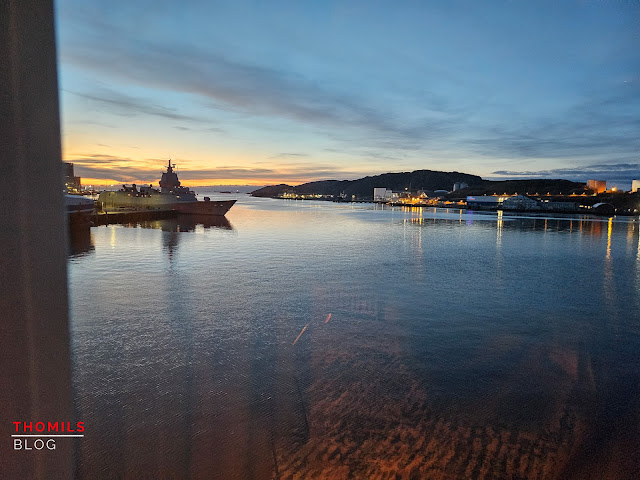 |
| Sunset over Bodø...at 3PM... |
 |
| That's a good burger! Seriously, the Havila burger is one of the best, if not the best burger I've ever had! |
 |
| HNoMS Roald Amundsen stands guard over Bodø as we leave to continue our trek north. |
After some time to let my legs recover, it was time to grab lunch. I’d missed my lunch slot in the main restaurant due to my excursion. However, my meal package also included a number of dishes and pastries on the menu of the Havly Café, also located on Deck 6 and aimed at port-to-port passengers. I’d heard good things about the signature “Havly Burger” and despite some delays, those stories turned out to be true. It was a simple burger, but one of the best I’ve ever had! By the time I’d ended the burger’s existence, night was beginning to settle over Bodø, and the last vestiges of daylight made for a magical experience as Havila Castor slipped her moorings and made its way out into the Vestfjord. Little did I know at this point that things were about to get utterly breathtaking! Why? I’ll let my words from that particular day speak for themselves:
An announcement is made. "They're out!" Within seconds, hundreds of people rush everywhere and nowhere to grab their jackets and cameras and only a minute or two later, everyone is outside. It's the closest I've ever seen to ordering "Action Stations" on a civilian ship.
And the hype is justified. Above us, in the gossamer wisps of the upper atmosphere, the tendrils of the solar wind tangle with our invisible shield, creating a stunning yet ethereal spectacle. As I gaze in awe at this solemn display of the cosmic forces above our heads, utterly indifferent to the manic trappings of human life, I cannot help but think of my parents. They would have loved to see this dazzling display of cosmic beauty, especially in this country, which was always beloved by both of them.
Mom, dad, I love you.






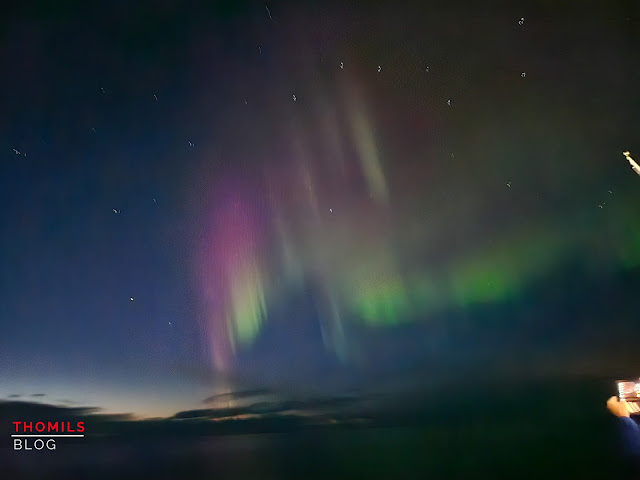
This wasn’t my first experience with the northern lights, I’d caught them earlier that year back home in Cork, but to watch them in the dark, out in the middle of the sea, was a whole different experience and I stayed out there on Deck 9 for over half an hour, despite the freezing cold temperatures and wind. Eventually though, I was driven back below deck and by the time we’d crossed the Vestfjord and reached our next stop at the port of Stamsund, the snow was coming down hard. To say I was bummed out by this was a bit of an understatement, given the rugged landscape and scenic nature of the Lofoten islands but then again, this weather was hardly unusual for this neck of the woods, and it did give the port and its characteristic warehouses a magical atmosphere. I watched as, once again, a familiar scene began to play out on the quay below. A number of locals left the ship, having travelled over from Bodø, a number of cargo pallets were dropped off, and a group of cruise passengers left the ship to head out on a Viking excursion, with a bus already waiting for them. We’d see them back in Svolvær, our next port.
 |
| Approaching the port of Stamsund, our first port of call in the Lofoten islands. |
 |
| The port is literally squeezed in between the sea and the mountains. |
 |
| Long exposure times and driving snow = some dramatic shots. |
 |
| Alongside at Stamsund: Locals waiting for our ship, a bus waiting for excursion passengers, and a number of pallets waiting to be loaded onto Havila Castor. |
 |
| Stockfish montecato as a starter at dinner. It's interesting, but not my favourite. |
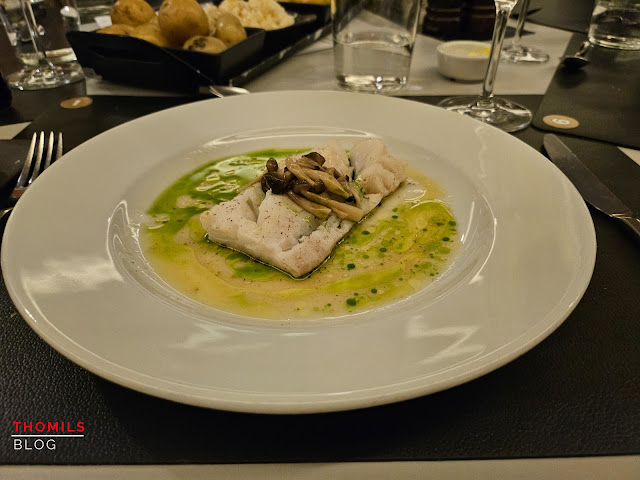 |
| The main though. That's baked Lofoten cod with brown & herb butter, and it's excellent! |
 |
| As is the dessert, a sea buckthorn & yoghurt sorbet! |
Dinner was served was we made our way up the coast of the Lofoten islands, with me opting to keep it local. Having said that, the stockfish montecato, an Italian interpretation of the dried cod that was, and continues to be, one of the economic lifelines of Lofoten, wasn’t my favourite. It wasn’t bad by a long shot, though, and both the Lofoten cod with herb butter and the sea buckthorn & yoghurt sorbet were uniformly excellent, as was rapidly becoming the norm on this journey. As we bobbed and rolled our way through the rugged and forbidding coastal waters of the islands, I couldn’t help but realise the dichotomy of our experience. On one hand, the experience aboard Havila Castor was equal, if no superior, to the majority of cruise ships out there, if one ignores the lack of entertainment. And yet, we were cruising through a landscape that had for centuries made the locals fight for their very survival, a landscape that, within living memory, had been mostly isolated from the rest of the world. Towns such as Stamsund and Svolvær had depended on the ships on the coastal route much longer than other places, even as Norway was beginning to benefit from its vast oil and gas reserves, and the arrival of a ship had often been a special occasion. Kari Bremnes, a singer and songwriter from Svolvær, had described the special atmosphere of a Hurtigrute ship coming into port in her eponymous song “Hurtigrute”, which had been played in that day’s daily briefing by the expedition team. In it, she sings of a ship coming in from afar, its arrival being like a tale from a thousand and one nights, with a taste of salt. She sings of the wondrous cargo this ship would bring, how its steel hull, and the captain with his black uniform jacket and gold rank stripes would seem like from a different world. And this wasn’t exaggeration or poetic license, she had lived this reality herself. It is with these thoughts in mind that I made my way into my cabin, after having watched our arrival into Svolvær at around 2200h local time. There was apparently some outdoor activity happening up on Deck 8 but honestly, I was absolutely wrecked.
 |
| Alongside at Svolvær, the capital of Lofoten. |
November 23rd – Day 4
 |
| Backup breakfast: Fresh pancakes with cream and some jam on the side... |
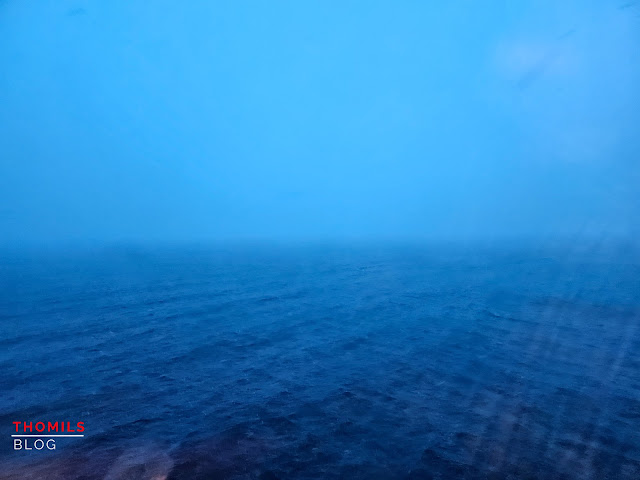 |
| A view like this makes the pancakes taste even better! |
 |
| It may have gotten warmer, but it's not exactly warm... |
My wake-up call arrived at around 0530h in the shape of some rough seas in the Andfjord, an area of open sea on the approach to Harstad. Once again, it wasn’t the seasickness as such that got me but the unpredictable nature of the ship’s movements, so by the time we reached calmer waters, I was officially over it. Up went the “do not disturb” sign on my cabin door, the lights were sent back to sleep, and so was I! This extended night was very much needed, but it also meant that missed breakfast. Not to worry though, because my meal package also included most meals in the Havly café, with the resulting breakfast consisting of freshly made pancakes with thick cream and jam, washed down with a coffee that was frankly superior to the one served by the free machines in the lounges. Besides, any breakfast tastes ten times better when eating it whilst watching snow come down hard through the panoramic windows of the ship you’re on. Yep, the weather wasn’t really on our side. Between the seemingly incessant snowfall and the fact that the cloud base was basically down on the deck, I was actually glad that I hadn’t managed to book the Tromsø excursion in time.





Thanks to the weather, much of the morning’s voyage to Tromsø, the main port of the day, was a quiet and anticlimactic affair, although I sure was glad most of the journey consisted of sailing through inside passages and sounds, protected from the ravages of the North Atlantic by a series of mountainous islands. It was also now that the northerly latitudes were really beginning to bite. It wasn’t so much the temperature, it was around 0°C the entire day, although that in itself would come back to bite me in Tromsø. Now, I’m talking about the increasing lack of daylight. Sunrise had only been at shortly before 1000h local time, and by the time we tied up alongside in Tromsø at 1415h, it was already pitch black again. And I was beginning to feel the effects, feeling tired, down and drained of energy.
 |
| Another lunch of "Norwegian tapas" as I've come to call them: Lyngen crabs on lemon mayonnaise & herbs (top), sourdough toast with aioli & pickled mushrooms (left), and grilled lamb sausage with mashed potatoes & sage butter (right) |
 |
| It's getting dark as we approach the terminal at Tromsø, even though it's just past 2 PM. |
 |
| Tromsø's famous Arctic Ocean cathedral may be visible in the gloom, but that's about it. |
I must admit though, Tromsø looked great, even in the dark. Pretty much every building was lit up, and the snowfall gave the whole city a magical vibe, something helped by the fact that a lot of the historic buildings in the city were still intact. Unfortunately, the relatively mild temperatures meant that a lot of the roads were covered in deep slush instead of snow, making getting around difficult. I’d planned to hop ashore in Tromsø to get some spikes for my shoes, something I’d forgotten to do before going on this trip, but the weather gave me pause. After some humming and hawing, I decided to take the risk anyway. We were moored neared to what looked like a cruise terminal anyway, surely, they’d have some spikes in there, right? Right?
 |
| Tromsø has a brand new terminal building at the coastal route pier. Unfortunately, it doesn't have any built-in gangway as in Bergen, meaning that on a day like this, you'll still trudge through the sludge... |
Yeah, about that. There were plenty of interesting stores in that terminal building, however none of them stocked spikes. To make things worse, for some reason, the terminal wasn’t equipped with the type of solid gangway we’d used in Bergen, so getting into the terminal meant getting down the onboard gangway, trudging through the slush and then going up again. Did they use Ryanair as design consultants here? Anyway, after hanging around the terminal for a bit, I decided to brave the slush and head into town, spikes or no. I eventually stumbled across a store that sold those things but nearly broke my legs on the way back to the ship due to missing a pothole buried under a pile of snow and slush. Eventually, I made it back aboard, with plenty of time to spare before our 1800h departure.
 |
| I will say though, Tromsø itself looks really pretty! |
 |
| Time to get back aboard after nearly breaking my legs in town... |
As we slipped our moorings for the next leg of our journey to Skjervøy, I couldn’t help but notice that our ship had gotten a whole lot busier. Not only were many locals using the ship to head to more remote ports such as Skjervøy, a number of guided tourist groups had also boarded the ship, with the majority of these being Chinese by the looks of things. The atmosphere on the ship didn’t change too much though, the air of calm that the ship exuded still prevailed. Having said that, the expedition team used the daily briefing to warn everyone that we were expecting rough seas overnight as we passed through the Lopphavet, past Hammerfest and on our approach to Honningsvåg, meaning we’d cross a lot of open ocean. They recommended taking seasickness medication and mentioned that they’d be doing so as well. They also advised us that, for a part of the journey, we wouldn’t have any internet connection.
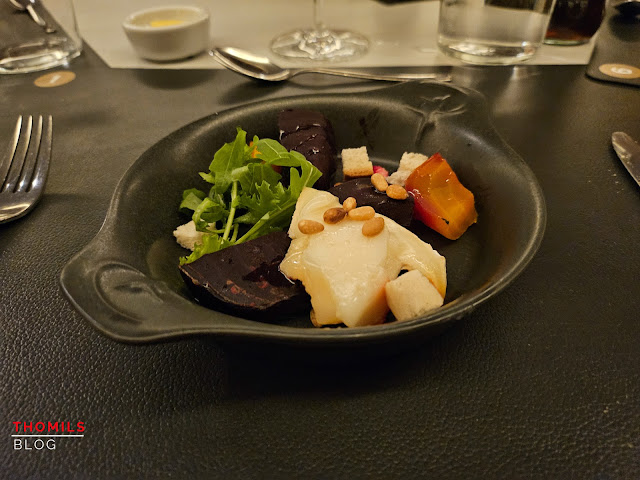 |
| Dinner starts with chèvre chaud with pickled beets! |
 |
| The porchetta I chose as my main course is excellent! |
 |
| The chocolate & blackcurrant mousse dessert is equally delicious! |
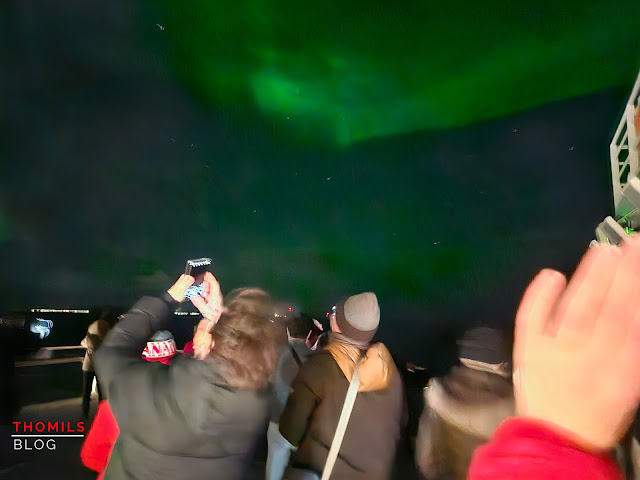


Thankfully, dinner took place in the far calmer inside passages. Once again, the selection was as interesting as it was varied, starting with chèvre chaud with beets as a starter, an absolutely excellent porchetta with a caper and apple sauce as the main, and ending with a chocolate and blackcurrant mousse for dessert. And not before time. The clouds had cleared as we left Tromsø and shortly after dinner, the northern lights were spotted again. The experience this time was far less impressive. Whilst the solid cloud cover had dissipated, there were still clouds around that would occasionally block the view. To make matters worse, many of the newly arrived passengers just cavorted around the viewing areas on Deck 9 with their cameras and their smartphone lights at full brightness, completely wrecking the night vision needed to properly capture the northern lights. This effectively ruined the experience for me. Besides, I’d already seen the northern lights twice that year, hadn’t I? Between this subpar experience, and the first taste of the heavy seas that were to come, I decided to call it a day relatively early, watching our port call in Skjervøy from my cabin.


November 24th – Day 5
 |
| The Barents Sea really opened up the taps overnight! |
 |
| I have to say that I love this view from my cabin window! |
The expedition team hadn’t exaggerated when they’d warned us about rough seas expected overnight. The night had been the roughest so far. I’d actually spent quite some time in my cabin just standing by the window and watching the waves after we’d left Skjervøy. Seeing the sheer forces at play out there had been humbling. Nearly every wave had caused the entire ship to shudder from our bow slamming into it. Looking out the window and seeing nothing but white at times, all the while sea spray had slammed into said cabin window had been quite the thrill ride.
 |
| We're deep in the Arctic now! |
The seas were still rough by the time I called it quits on my all too short night and decided to make myself presentable. You can take it from me, showering whilst the entire shower is rolling, pitching and yawing all at the same time is quite the experience. The view out the window was pretty bleak, understandably so. We were in the high Arctic at this point, further north than even most of Siberia or Alaska. We also wouldn’t see a sunrise, and not just because of the cloud. Havila Castor was now so far north that we had entered the polar night, where the sun never rises above the horizon. This was not a land made for humans, make no mistake. And yet, humans not only lived but thrived here.
We pulled into the port of Honningsvåg, the gateway to the North Cape, with a slight delay. This was the big day for me, the one shore excursion I’d planned for from the beginning. I was going to go to the North Cape, the northernmost point of Europe. By the time we had tied up at the quay, the buses were already waiting for us. It was a bit of a walk from the ship to the buses and between the much colder weather, the biting northeasterly winds, and the frozen ground, trudging to the buses was no fun at all.
 |
| Driving out of Honningsvåg on our way to the North Cape. |
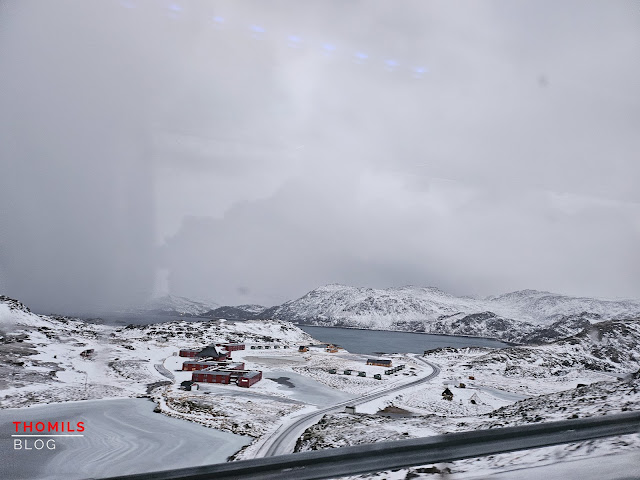 |
| There are plenty of hotels and holiday camps here that are jam-packed in the summer. But now, with polar night upon the region, they're almost all closed. |
A total of four tour buses set out for the cape, with me being in the last of these four buses. As we made our way out of Honningsvåg and onto the central plateau of Magerøya, the island that houses both Honningsvåg and the North Cape, it soon became clear just how far north we were. The central plateau was utterly devoid of trees, the ground covered in wind-driven snow, with only the occasional rocky outcrop breaking the vast expanse of white. This air of magnificent desolation was only reinforced by the aforementioned northeasterly winds continuously drove show showers across the plateau. By the time our little convoy of buses reached the plateau, we were driving on pure snow, the road clearing teams only keeping the roads in and around Honningsvåg somewhat clear.
 |
| No trees anywhere around, just miles and miles of forbidding, frozen ground! |
 |
| That wasn't supposed to happen! the lead bus in our little convoy has just been blown off the road! |
We were about a quarter of our way to the cape when it happened. As our excellent tour guide was explaining the landscape around us, and how life was actually like this far north, a series of gasps and muffled shouts rippled through our bus. I looked out the window. Ahead of us, the second bus in our little convoy was slowly being pushed off the road and into the snow piled up on the westerly side of the embankment, dangerously leaning to one side. I suspect that it must have somehow hit an icy patch on the road with its rear wheels, which was enough for the wind to slowly push it off the street. After a few minutes of phone calls by the driver and tour guide, the announcement that I’d already suspected came. The tour to the North Cape was cancelled, the conditions were simply too treacherous. It took around ten or fifteen minutes more for the drivers to work out the battle plan. The bus that had driven ahead had been recalled and picked up some of the stranded passengers on its way back. Eventually, both the bus ahead of us and my bus both got moving again. Turning around on the two-lane road was simply impossible, and neither driver dared to reverse in the current conditions. Instead, we drove past the bus and continued on the road until we reached a lookout point ahead where we could use the car park to turn around. The bus ahead of us picked up the remaining passengers, so that by the time we passed the scene of the incident, only the driver of the ill-fated bus was still waiting for us. Even the stricken bus had left the scene, sliding slowly down the road embankment. Thus ended our little North Cape adventure. About an hour after departure, we were back on the quay, and shortly afterwards, back aboard Havila Castor. I will say though, some of the comments of my fellow passengers on the bus made me feel ashamed to be German. The sheer sense of entitlement, the backseat driving and mind-numbing hubris just reaffirmed my decision to emigrate all those years ago, and my decision not to return to Germany.
 |
| On our way back to Honningsvåg and the ship... |
 |
| Passing the runway lights of Honningsvåg airport (centre right) on our way back. |
 |
| There's just something about the seemingly eternal twilight up here this tine of the year. |
 |
| Fishing is one of the mainstays of the economy up here. |
 |
| Havila Castor alongside the pier at Honningsvåg. |
 |
| Viewed from the observation lounge, the town looks magical! |
 |
| Coffee and a weapons-grade pastry are just what's needed after that trip! |
Back on the ship, the expedition team was already waiting for us, having arranged for some hot soup to be brought up from the galley up to Ten Forward. Whilst I wasn’t a fan of the soup, I was still grateful, as even the short walk from the bus park to the ship had been enough to chill me to the bone. Those easterlies were no joke! The light was spectacular, despite the lack of any actual sunrise. This perennial dawn/dusk mood gave Honningsvåg a cozy look, totally at odds with the literal arctic air outside. I whiled away the hours until our departure in the bow lounge with a coffee and some excellent pastries from the café. Unfortunately, by the time we left, darkness had fallen again and to get to our next scheduled port, the fishing village of Kjøllefjord, we had to cross the open entrances to both the Porsangerfjord and Laksefjord. This meant that we would once again be exposed to the tender administrations of the Barents Sea, something that was likely to continue throughout the night as there was no sheltered passage between Honningsvåg and Kirkenes, our main port of call the following day and the turnaround point for us. Subsequently, a lot of chairs remained empty at dinner that evening. I myself opted for some safe options as well, going for a salmon carpaccio, a surprisingly tough sailor’s steak and the ever-delicious sea buckthorn panna cotta.
 |
| Yeah, it's rough out there... |
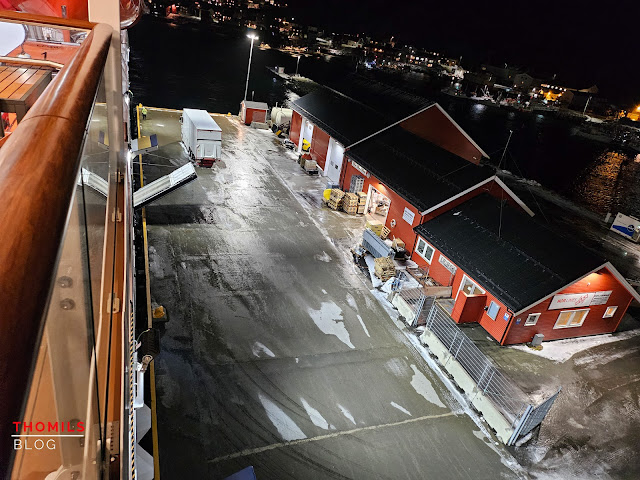 |
| Coming alongside at Kjøllefjord. |
 |
| Alongside. It's pitch black out even though it's only 5 PM! |
 |
| Driving snow welcomes us as we approach Mehamn. |
 |
| No passengers are taken aboard here, although we do have four pallets of cargo waiting for us. |
 |
| Those covered outside areas on Deck 8 are priceless in weather such as this. |
 |
| Lady Aurora makes another appearance... |
Kjøllefjord and Mehamn were once again short calls, primarily aimed to provide a cargo and transport service for locals. Despite the freezing weather, we actually had some passengers waiting for us on the quay as we arrived into Kjøllefjord at around 1700h, despite the freezing weather and the complete darkness. By the time we arrived at Mehamn, the weather had turned, and it was snowing heavily as we took on a surprisingly large number of cargo pallets for what looked like a pretty small port. It was after dinner, as we were approaching the port of Berlevåg, that yet another sighting of the Northern Lights was report. They were out alright, but pretty faint. I’m not sure if I was just getting jaded or if the rough seas were beginning to have an effect on me, but I remember not being impressed with that particular display. I stayed up just long enough to watch our arrival into Berlevåg, probably the loneliest port on our journey. Here, the quay used by the coastal route was located quite a ways away from the town itself, right behind the main breakwater. Consequently, the single linesman ashore who was waiting for us, and who also operated the forklift that was used to load any cargo, cut a pretty lonely figure in the darkness, an impression not helped by the fact that all that was waiting for us in this port were two pallets of cabling. As we left Berlevåg behind, and as the floodlights on the pier were turned off, I headed into my cabin to catch some much-needed sleep.


 |
| Berlevåg has got to be the loneliest port we've called at. Just a single pier, no one around except a single worker and two pallets of cargo that are waiting to be loaded aboard. |

















































































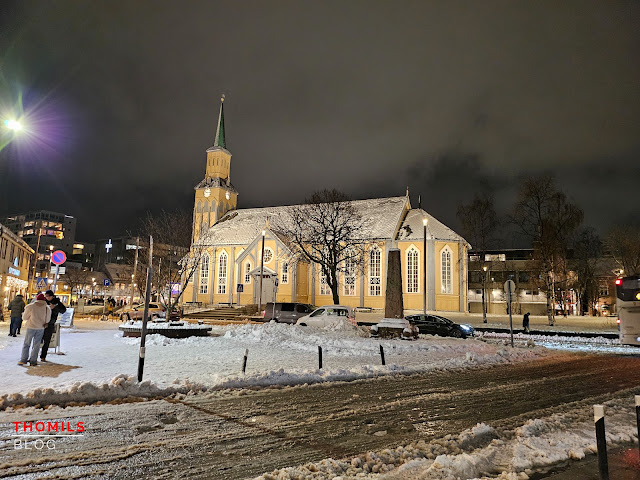
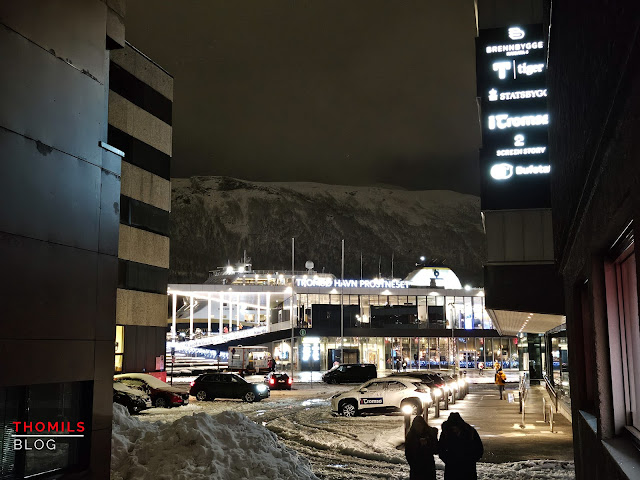










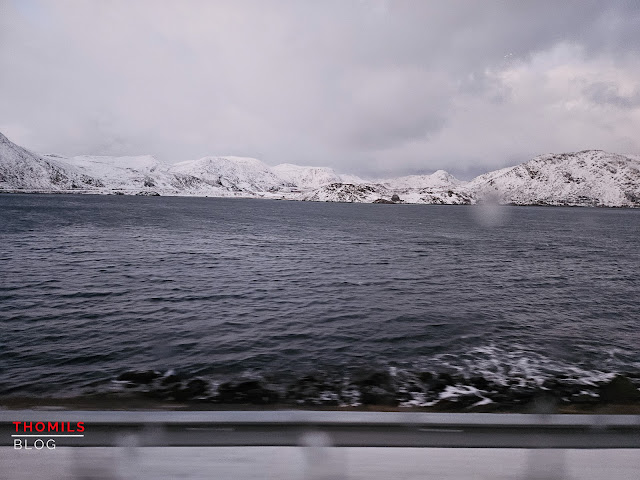











Comments
Post a Comment